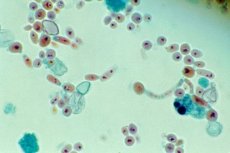Pathogens of superficial mycoses
Last reviewed: 23.04.2024

All iLive content is medically reviewed or fact checked to ensure as much factual accuracy as possible.
We have strict sourcing guidelines and only link to reputable media sites, academic research institutions and, whenever possible, medically peer reviewed studies. Note that the numbers in parentheses ([1], [2], etc.) are clickable links to these studies.
If you feel that any of our content is inaccurate, out-of-date, or otherwise questionable, please select it and press Ctrl + Enter.

Surface mycoses (keratomycosis) cause keratomycetes - low-contagious fungi affecting the stratum corneum of the epidermis and the surface of the hair. These include:
Pityrosporum orbiculare are common yeast-like lipophilic fungi that live normally on human skin. Causes pityrious (motley, colorful) lichen, characterized by the appearance on the skin of the trunk, neck, hands of pinkish-yellow non-inflammatory spots. When scraping on spots appear scales, similar to bran. In flakes treated with 20% alkali, short curved hyphae and yeast-like budding fungal cells are detected. They are grown on media containing lipid components. Colonies grow better under a layer of sterile olive oil. Growth is observed after a week in the form of creamy whitish cream colonies consisting of oval, bottle-shaped budding cells 2x6 μm in size. Treatment with amphotericin B, ketoconazole, fluconazole.
Exophiala werneckii causes black lichen. On the palms and soles appear brown or black spots. Fungus occurs in the tropics. It grows in the stratum corneum of the epidermis in the form of budding cells and fragments of brown, branched, septated hyphae. Forms melanin, grows on sugar media in the form of brown, black colonies. Colonies consist of yeast-like cells. In old cultures, mycelial forms and conidia predominate. Detection of the fungus is carried out by microscopy of a smear from a clinical material treated with potassium hydroxide. Treatment with antimycotic topical application.
Piedraia hortae causes mycosis of the scalp - a black piedra (piedriasis) found in the tropical regions of South America, Africa and Indonesia. On the infected hair appear dense black nodules with a diameter of 1 mm, consisting of dark brown septate, branching threads 4-8 microns thick. Colonization of the hair, up to the introduction of the fungus into the cuticle, occurs as a result of sexual reproduction of the fungus (teleomorph). Cultures that grow on Saburo's environment reproduce asexually (anamorph). Colonies small dark brown with velvety edges. They consist of mycelium and chlamydospores. Assign antimycotics topical application.
Richosporon beigelii causes a white piedra (trichosporosis) - an infection of the hair shafts of the head, mustache, beard. The disease is more common in countries with a tropical climate. The causative agent is a yeast-like fungus, forming a greenish-yellow cover of solid nodules around the hair and damaging the cuticle of the hair. Septic typhus fungus 4 μm thick is fragmented with the formation of oval arthroconidia. On the nutrient medium, cream and gray wrinkled colonies are formed, consisting of septic mycelium, arthroconidia, chlamydospores and blastoconidia. Treatment with flucytosine, drugs of the nitrogen series; Effective also removal of hair with a razor and observance of personal hygiene.


 [
[